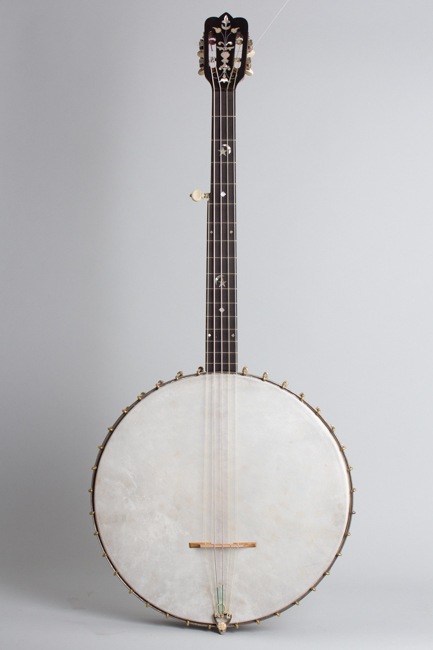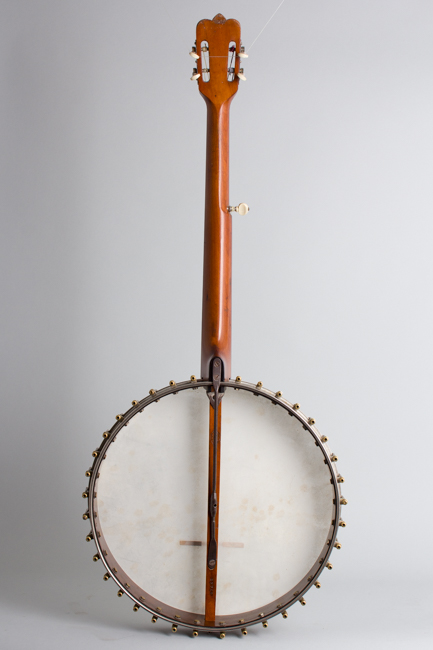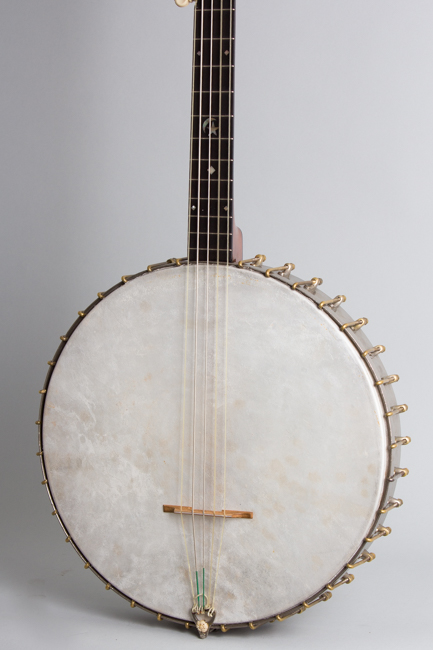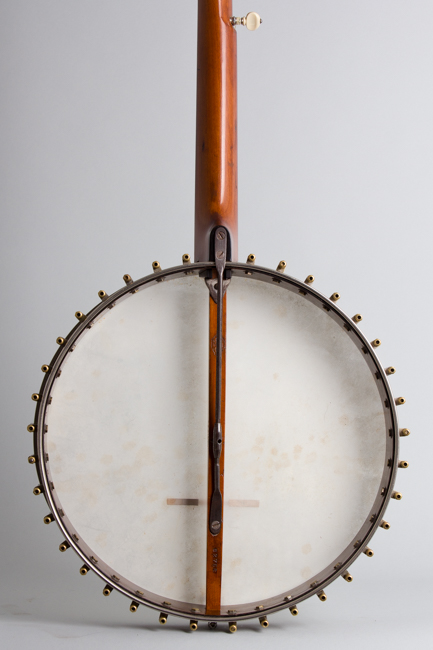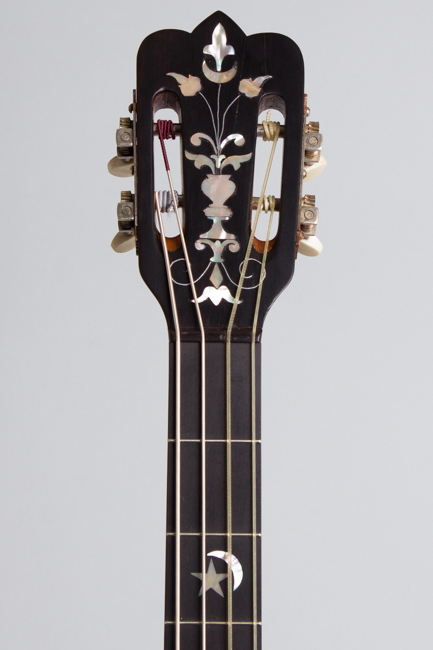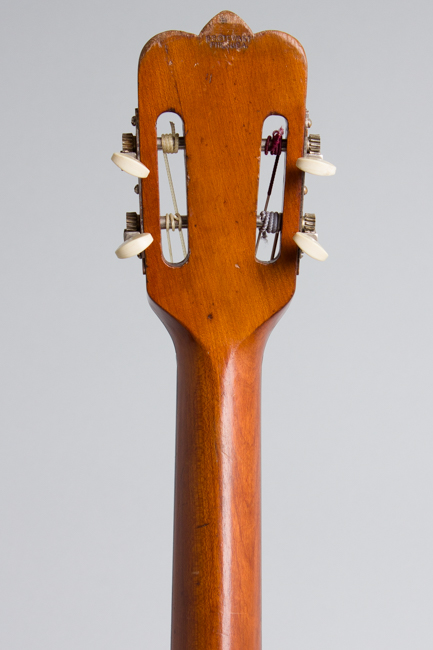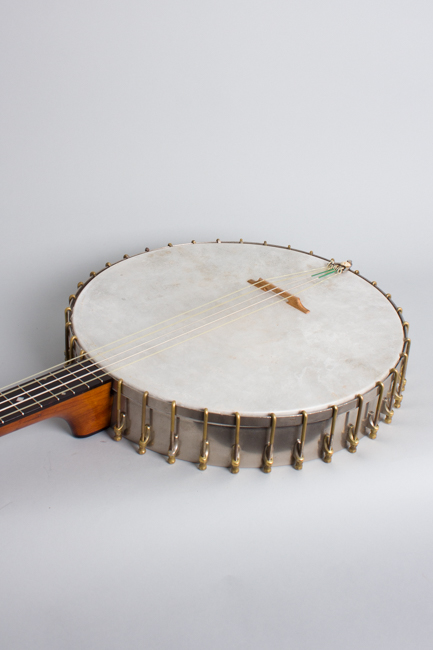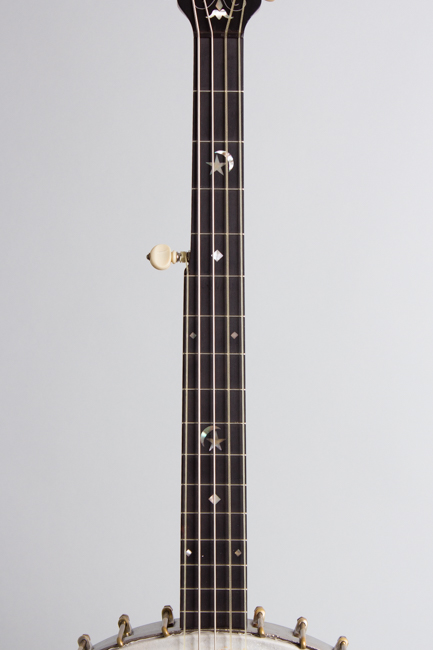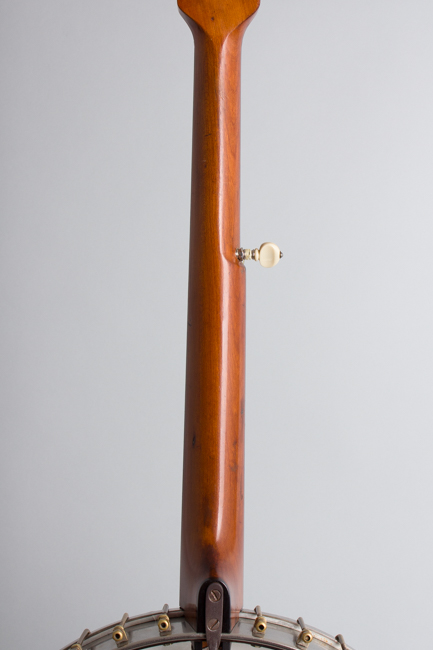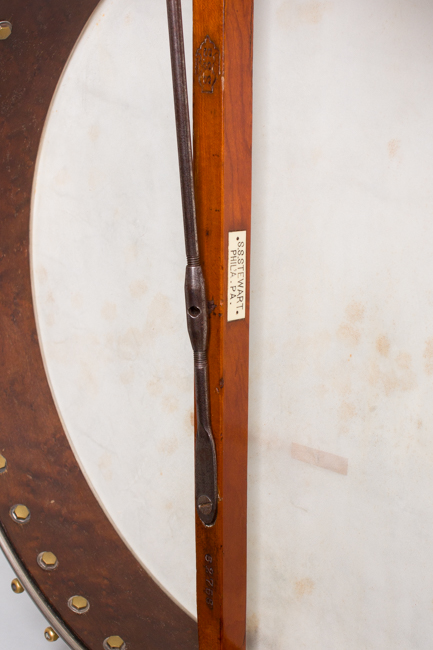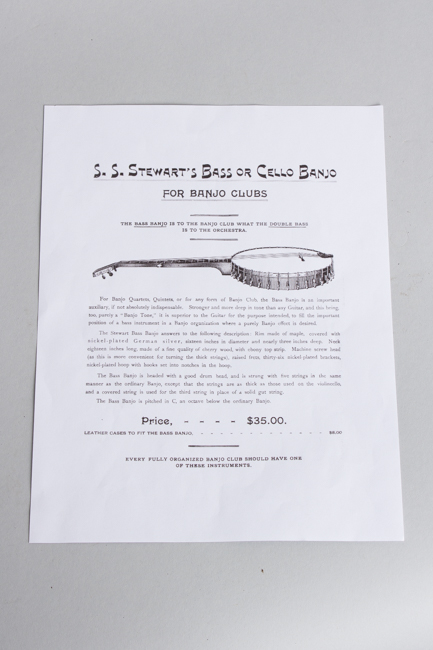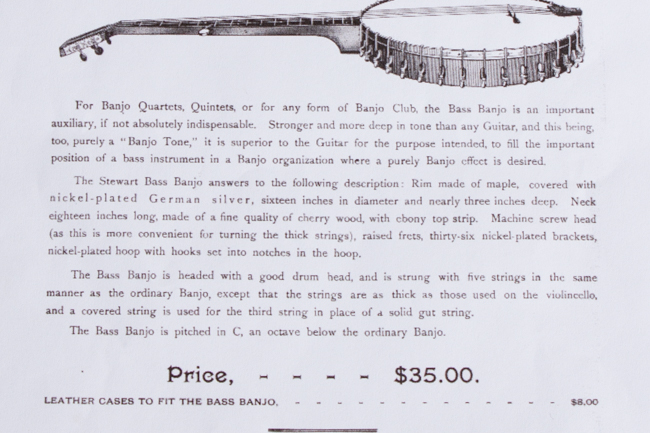S. S. Stewart Cello Banjo , c. 1900
This item has been sold.
Item # 11959
Prices subject to change without notice.
S. S. Stewart Cello Banjo, c. 1900, made in Philadelphia, PA, serial # 52758, natural varnish finish, spunover rim, cherrywood neck with ebony fingerboard.
Ladies and gentlemen, behold the wonder of the banjo age! Well, if that age was around 1895, that is. While not the largest banjo ever attempted, this creation of S.S. Stewart's Philadelphia company is up there. "Every fully organized banjo club should have one of these instruments" trumpeted the publicity page "an important auxiliary, if not absolutely indispensable!". This instrument was actually called the "Bass or Cello banjo" in the catalog, continuing "It is strung in the same manner as the ordinary banjo, except that the string are as thick as used on the violincello".
This imposing beast is a product of the late 19th century fascination with banjos of all sizes, from the toy-like "Piccolo Banjo" with a 7" rim to this 16" rim bass instrument. Much of the impetus for building banjos in many assorted sizes came from S.S. Stewart but some other makers latched onto the idea as well. They were originally intended to be played in large banjo ensembles, with this instrument handling the bass lines in the orchestral arrangements. "Stronger and more deep toned than any guitar" Stewart claimed, and he's not wrong although the tone of course is completely different. It was claimed "to fill the important position of a bass instrument in a banjo organization where a purely banjo effect is desired".
To achieve these lofty goals Stewart produced this model, which was a standard catalog piece although exceptionally rare today. The just-over 16" rim is of standard spunover construction if deeper than normal. The cherry wood neck has a 29" scale with a heavier-than standard ebony fingerboard, with some attractive shaped pearl inlay in typical Stewart moon-and-star patterns. The slotted headstock is in a more guitar-like than banjoistic layout with geared machines and a nice abalone floral pattern on the face. The dowel is fitted with Stewart's patented turn-buckle adjustor, which is more than usually useful on an instrument this size.
The instrument has been set up as closely as possible to Stewart's original specifications, with gut cello strings as specified in the 1890s catalogs. It is set up in 5-string banjo tuning, although pretty much anything would be possible with appropriate stringing. A repro page from the c.1890 Stewart catalog is provided for reference. While obviously a historical oddity and specialty piece par excellence this is also a fully playable instrument, and would still be the hit of any banjo club gathering!
Overall length is 40 1/2 in. (102.9 cm.), 16 1/4 in. (41.3 cm.) diameter head, and 3 in. (7.6 cm.) in depth, measured at side of rim. Scale length is 29 in. (737 mm.). Width of nut is 1 1/2 in. (38 mm.).
This (at least) 125 year old instrument remains largely original, showing some wear and minor restoration but overall nicely preserved and quite playable. The plating and finish on the rim is original; there is some general wear but nothing to severe. The extra-long hooks and nuts are not plated, but may have been that way from the start, it's impossible to tell. The neck has the original finish on the back with some dings and dents, the headstock face appears to have been buffed out. The tuners are original 2-on-a-plate guitar style machines; the 5th string tuner is later. The tailpiece is original with a nicely done repro rosette. The fingerboard is a heavier piece of ebony than we usually see on Stewarts; it is a very well done repro using the original inlay and an ebony nut.
The instrument is fitted with a (enormous) genuine calfskin head; the flesh hoop has slipped under the rim hoop for a section of the treble side of the rim but the head is holding steady. The strings are genuine Gamut gut cello strings (which are enormously expensive!) that really complement the instrument and sound great. This unique creation has a deep thump; it is not particularly loud but quite satisfying to play, most effectively in a single-note mode. It is quite resonant and has a more controllable sound when slightly muted in the old-time manner with something between the dowel and the head. We're not sure where this fascinating banjo dinosaur fits into the modern world, but it sure is fun to play! Overall Excellent - Condition.
Ladies and gentlemen, behold the wonder of the banjo age! Well, if that age was around 1895, that is. While not the largest banjo ever attempted, this creation of S.S. Stewart's Philadelphia company is up there. "Every fully organized banjo club should have one of these instruments" trumpeted the publicity page "an important auxiliary, if not absolutely indispensable!". This instrument was actually called the "Bass or Cello banjo" in the catalog, continuing "It is strung in the same manner as the ordinary banjo, except that the string are as thick as used on the violincello".
This imposing beast is a product of the late 19th century fascination with banjos of all sizes, from the toy-like "Piccolo Banjo" with a 7" rim to this 16" rim bass instrument. Much of the impetus for building banjos in many assorted sizes came from S.S. Stewart but some other makers latched onto the idea as well. They were originally intended to be played in large banjo ensembles, with this instrument handling the bass lines in the orchestral arrangements. "Stronger and more deep toned than any guitar" Stewart claimed, and he's not wrong although the tone of course is completely different. It was claimed "to fill the important position of a bass instrument in a banjo organization where a purely banjo effect is desired".
To achieve these lofty goals Stewart produced this model, which was a standard catalog piece although exceptionally rare today. The just-over 16" rim is of standard spunover construction if deeper than normal. The cherry wood neck has a 29" scale with a heavier-than standard ebony fingerboard, with some attractive shaped pearl inlay in typical Stewart moon-and-star patterns. The slotted headstock is in a more guitar-like than banjoistic layout with geared machines and a nice abalone floral pattern on the face. The dowel is fitted with Stewart's patented turn-buckle adjustor, which is more than usually useful on an instrument this size.
The instrument has been set up as closely as possible to Stewart's original specifications, with gut cello strings as specified in the 1890s catalogs. It is set up in 5-string banjo tuning, although pretty much anything would be possible with appropriate stringing. A repro page from the c.1890 Stewart catalog is provided for reference. While obviously a historical oddity and specialty piece par excellence this is also a fully playable instrument, and would still be the hit of any banjo club gathering!
Overall length is 40 1/2 in. (102.9 cm.), 16 1/4 in. (41.3 cm.) diameter head, and 3 in. (7.6 cm.) in depth, measured at side of rim. Scale length is 29 in. (737 mm.). Width of nut is 1 1/2 in. (38 mm.).
This (at least) 125 year old instrument remains largely original, showing some wear and minor restoration but overall nicely preserved and quite playable. The plating and finish on the rim is original; there is some general wear but nothing to severe. The extra-long hooks and nuts are not plated, but may have been that way from the start, it's impossible to tell. The neck has the original finish on the back with some dings and dents, the headstock face appears to have been buffed out. The tuners are original 2-on-a-plate guitar style machines; the 5th string tuner is later. The tailpiece is original with a nicely done repro rosette. The fingerboard is a heavier piece of ebony than we usually see on Stewarts; it is a very well done repro using the original inlay and an ebony nut.
The instrument is fitted with a (enormous) genuine calfskin head; the flesh hoop has slipped under the rim hoop for a section of the treble side of the rim but the head is holding steady. The strings are genuine Gamut gut cello strings (which are enormously expensive!) that really complement the instrument and sound great. This unique creation has a deep thump; it is not particularly loud but quite satisfying to play, most effectively in a single-note mode. It is quite resonant and has a more controllable sound when slightly muted in the old-time manner with something between the dowel and the head. We're not sure where this fascinating banjo dinosaur fits into the modern world, but it sure is fun to play! Overall Excellent - Condition.
